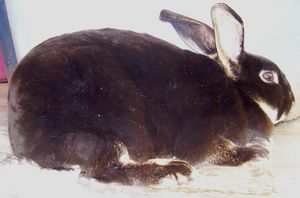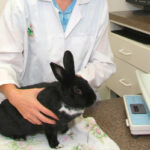The gestation period of rabbits should, ideally, begin before the buck has ever been chosen. Having your doe in good condition is important. Not too fat, but not too thin either. Always take the doe to the buck, never the other way around. Gestation averages 31 days but can be a few days longer or shorter.
Using good quality feed is important particularly for breeding rabbits. Make sure your doe is healthy and that you have a plan for the offspring. This can be showing, meat, pets, selling for pet food or any number of other uses but have a clear plan. Although it’s thought that they “breed like rabbits” there are many things that can go wrong.
Once your doe is bred do not increase her feed! While show animals carry plenty of flesh condition do not allow working does to be that heavy. They shouldn’t have hip bones showing of course but should not be fat. Fat does have a much higher incidence of kindling problems and in some cases it results in losing the doe. Pregnancy toxemia, dystocia and other problems can happen but the chances are decreased with a fit, slender doe. Only in the last week or so, during the majority of growth when you know for sure that she’s bred, should she have food increased slightly to build up for the milk flow.
The typical litter size depends on breed but remember that does with a litter will need more room than just for them. Small breeds may just have a couple bunnies but larger commercial breeds should produce 6-10 kits. I’ve had a mini-Rex have 13 and a Rex have 13. Dutch sized medium breeds 4-6 are common. Ideally have a different color or breed bred at the same time in case there are babies that need fostered. They’re much more likely to make it with a foster doe.
Usually, but not always, the doe will “pull fur” to line the nest box and her babies will be down in the midst of this. If there’s a baby born on the wire and it can be warmed you can often slip it into the nest box without a problem.
During gestation gently palpate about 16-18 days after breeding to make sure she’s pregnant. Good care and management can produce litters every 6-8 weeks but that normally is for high volume commercial meat rabbit places. For the home breeder looking for show or other rabbits few push their does to that level.
Proper weight, housing and nutrition goes a long ways towards a comfortable gestation for your doe. Make sure she also has plenty of clean water. About 4 days before her due date put a nest box with straw or hay in it. Some breeders put a handful of shavings in the bottom but no more than that and never use sawdust. Either can interfere with the bunnies from a respiratory standpoint. When you put a handful of straw in the cage and she starts collecting it in her mouth and looking for a place to put it then it’s time to put the nest box in with her. Give her time to make a nest and insure her babies are born in the nestbox. Always check to make sure that all the babies are alive with full bellies. You can quickly check daily and remove any dead ones promptly.
Breeding should always have a plan and knowing your rabbit and the gestation period is a part of that.







